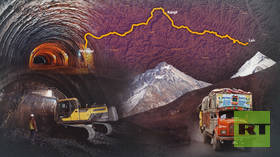India to complete vital road near China border next month – report
A military base along the Line of Control will be linked by a more efficient route, allowing movement of weapons and soldiers
India is close to completing a road that will provide an alternative link to its northernmost military base, near the border with China, the Hindustan Times reported on Friday, citing unnamed Indian officials.
The development signifies an extensive push by India to fortify its settlements near the border with its neighbour, amid strained ties.
Around 2,000 people are working on the project, providing a new transport connection to the Daulat Beg Oldi (DBO) base, which lies to the west of the contested Line of Actual Control (LAC) in the Karakoram Range in northern Ladakh, the report noted.
The new road cannot be sighted from across the border, and lies further away from the LAC than the existing Darbuk–Shyok–DBO road, making it less vulnerable to attacks, an official told the outlet. The route is likely to be ready to support “critical military movement” by the end of November.
While the existing 255 km road connects the DBO base to Leh city, the new 130 km artery will link Sasoma, a much smaller settlement, to the military base. Construction has reached its most challenging phase, as it requires India to finish a stretch in steep glaciated terrain and build a bridge on the Shyok River.
“Latest technologies are being employed to clear construction hurdles in the final lap,” the official told the newspaper. The report also detailed that several key sections of the Sasoma-Saser La-Saser Brangsa-Gapshan-DBO have already been completed.
Depsang was a flashpoint in the India-China border row in 2013. On April 15 that year India reported an “incursion” by a large contingent of the Chinese People’s Liberation Army (PLA) in the dry riverbed of Raki Nala in the Depsang Bulge.
Indian troops responded to the Chinese presence by establishing a camp 300 meters away. Negotiations between China and India lasted nearly three weeks, and the dispute was resolved the following month. India alleged that Chinese troops had strayed 10 km into Indian territory.
Since the deadly clashes between Indian and Chinese forces in the Galwan Valley in 2020, India’s Border Roads Organization (BRO), the body that develops and maintains road networks in the country’s border areas, has ramped up infrastructure operations in the region. BRO has completed 300 crucial projects at a cost of 80 billion rupees ($963 million) in the last three years.
Meanwhile, India’s relationship with its neighbour remains frosty, despite efforts to resolve border issues. Last month, a Chinese ‘standard map’ showing the contested areas of Aksai Chin and Arunachal Pradesh as parts of China triggered fresh outrage in India, which lodged a protest with Beijing.
The map’s publication came days after a meeting between Indian Prime Minister Narendra Modi and Chinese President Xi Jinping on the sidelines of the 15th BRICS summit in Johannesburg, South Africa.
Modi and Xi agreed to “direct their relevant officials to intensify efforts at expeditious disengagement and de-escalation,” India’s Foreign Secretary Vinay Kwatra told media after the meeting.
He added that New Delhi has conveyed its concerns on the unresolved issues along the LAC, and underlined that maintaining peace and tranquillity in the border areas is “essential for the normalisation of the India-China relationship.”
You can share this story on social media:








Comments are closed.